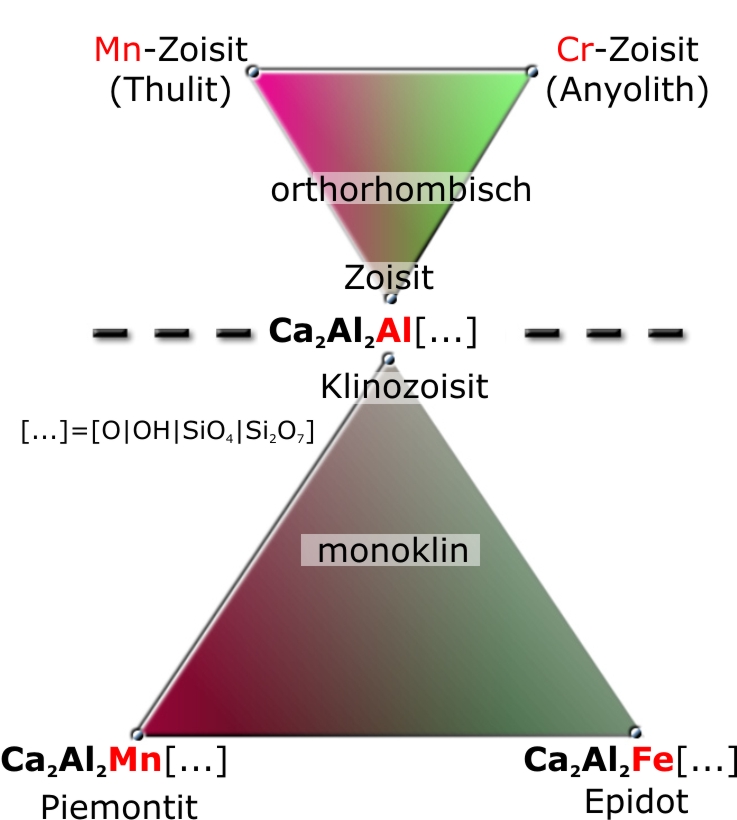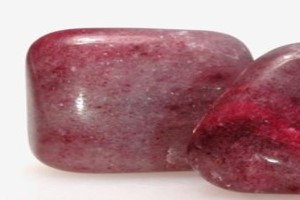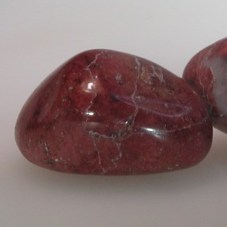
Fig. 1: Chemical composition of some minerals from the epidote-zoisite group
Grafic: © EPI-Institut
_____________________
The mineral zoisite is a calcium (Ca) - aluminum (Al) silicate with the formula Ca2Al3[O|OH|SiO4|Si2O7]. It is capable to form single large crystals, but also massive rock bodies. By incorporation of the element manganese (Mn) into the crystal lattice, zoisite gets a pink to brown-red color (trade name: »Thulite«). Chromium Turns tho color of the mineral into green (trade name: »Anyolite«) and vanadium into blue (trade name: »Tanzanite«). Zoisite forms crystal shapes with orthorhombic symmetry.
Similar to the pyroxene family, there are a number of members in this family that form crystal shapes with monoclinic symmetry. These are called "clinozoisite". The name means something like "the crooked zoisite" and is based on the close relationship to the chemically identical, but orthorhombic zoisite. The manganese-bearing variety of clinozoisite bears the name piemontite. The incorporation of iron (Fe) leads to the green mineral epidote.
Manganese - Zoisite (Thulite)
The best known occurrence of the pink zoisite variety »Thulite« is in Norwayin the region of Lom. The deposit is located in a zone of gneisses of sedimentary origin (paragneisses), in which numerous inhomogeneities such as quartz lenses and amphibolites occur. Embedded is a layer of manganese-rich minerals measuring approximately 3 x 250 m. As mining has reached the margins of the deposit , hardly any fresh, high-quality material comes onto the market.
Instead, another rock from the area is more and more offered, which is to be addressed as "piedmontite-muscovite-quartzite" or short: "piedmontite-quartzite" because of its high quartz, piedmontite and muscovite content. Both rocks look similar and are often confused because of the misleading marketing under the same name.
Manganese - Clinozoisite (Piemontite)

Fig. 3: Piemontite-muscovite quartzite with typical speckled appearance.
Image: K. Sieber, www.makrogalerie.de
Piemontite-muscovite quartzite from the deposit near Lom has an uneven, mottled color distribution. It is relatively soft (Mohs hardness 2 - 7) and often exhibits a striking "glitter" light effect called "aventurizing".
X-ray spectrometric studies (EDX) have shown that it is a rock containing varying proportions of piedmontite, thulite, quartz, muscovite, tremolite and calcite, depending on the sample.
It is noticeable that in the samples examined, as the piedmontite content increases, the muscovite content also increases. Muscovite is a very soft mineral with a Mohs hardness of 2 and occurs preferentially in foliated form. The characteristic metallic light reflections of these mica platelets lead to a distinct aventurization. Therefore the rock is also offered as »red aventurine quartz«. The mineralogically correct name is: piedmontite-muscovite-quartzite.
Because of its striking glitter and wine-red color, this new material is used as a gemstone or is processed into tumbled stones.
Distinction features
In practice, the following clues are helpfull to distinguish the three rocks:
- Since Thulite always occurs together with other minerals in the rock thulitite, the physical properties such as hardness or density are inconsistent. Transitions to the piedmontite-muscovite-quartzite are possible. Thulitite usually has a density between 3.0 and 3.5, rhodonite has a density bigger than 3.5 and piedmontite quartzite less than 3.0.
- Piedmontite often occurs in the form of blood red, punctate inclusions in the rather colorless quartzite host rock. A glittering surface indicates the presence of mica, which often occurs as an accompanying mineral of the piedmontite quartzite.
Ref.: HAINSCHWAG, T., NOTARI, F. (2012): Zoisit - More than just Tansanit, InColor, 19, 44-54
Autor: Dipl.-Min. B. Bruder
© INSTITUT FÜR EDELSTEIN PRÜFUNG (EPI), 2021
Read more on this topic:




